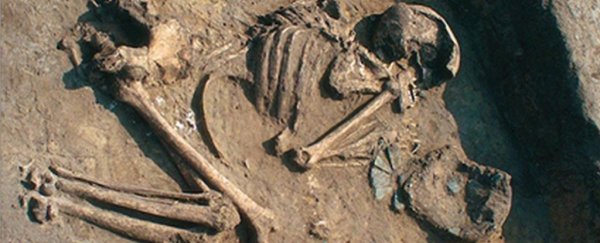Even in early prehistoric Europe, there was a clear wealth gap between the rich and the poor, and this inequality in life followed people long after their deaths.
New archaeological research in Poland reveals the richest humans from Neolithic times were also the ones buried with the most exotic artefacts.
This might sound obvious, but it was not the connection archaeologists were initially after. The study of these 6,600-year-old grave sites, located in the town of Oslonki, was supposed to reveal what Neolithic farmers used to grow and eat all those years ago.
It just so happened that the richest diets also aligned with the most valuable buried artefacts.
During this time, it appears the artefacts humans were buried with were not simple funerary donations by hopeful family members, but direct translations of material wealth from life into death.
"We have uncovered some of the earliest evidence for a direct link between social status and long-term diet in prehistoric Europe," says archaeologist and anthropologist Chelsea Budd from Umeå University in Sweden.
"We are witnessing the emergence of social and economic inequality in early prehistoric communities – the 'haves' and the 'have nots' - at a time much earlier than we thought."
Examining the bones of 30 people, all buried within the same 200 years, the international team found that skeletons containing more carbon-13 isotopes were often buried with fancier grave goods, made of copper.
These isotopes accumulate in food sources at different rates, and are subsequently incorporated into human tissue, thus giving us a potential glimpse at the person's diet during their life. However, exactly what carbon-13 can tell us about Neolithic food is limited. It could possibly suggest more dairy intake, for instance, but there's little evidence of this in the region.
It could also suggest some people had access to plants and animals that were isotopically different from the rest. And this isotopic balance was also seen in cattle bones found in the area.
This implies that some people and animals had privileged access to large fields and more lush pastures well lit by the sun (which leads to more carbon-13 in the plants), while others didn't.
"Perhaps founding members of the community had privileged access to these fields, and, by extension, to the exchange networks that brought exotic copper ornaments this far north," the authors suggest.
"Although speculative, this is a plausible scenario given the abundant ethnographic evidence for the importance ascribed to the 'first settlers' in a region and/or to a community's founders."
What's more, it could very well be argued that these lands were passed down, exhibiting some of the earliest forms of generational wealth.
No matter the specifics, the findings do suggest there was some sort of dietary difference between those who were buried with copper materials and those who weren't.
The copper artefacts discovered, including 50 strips, 200 beads, five pendants and a diadem, were likely brought in from sources hundreds of kilometres away - another line of evidence that suggests they belonged to the richest.
When Oslonki and other nearby sites were abandoned for an unknown reason sometime around 4,500 BC, copper ornaments in northern Europe stopped showing up for a millennium, suggesting the town was an important part of the trade networks involving these precious goods.
"That the system appears quite short-lived highlights that early attempts at developing hierarchical structures were not always successful in the long term," the authors note.
While there's some evidence for income inequality amongst human society in the later Bronze Age of Europe, this new study suggests the wealth gap - a phenomenon we experience to this day - goes back even further in history.
The study was published in Antiquity.
